
December
2019 |
 |
|
|

1919: Vestiges of the Great War
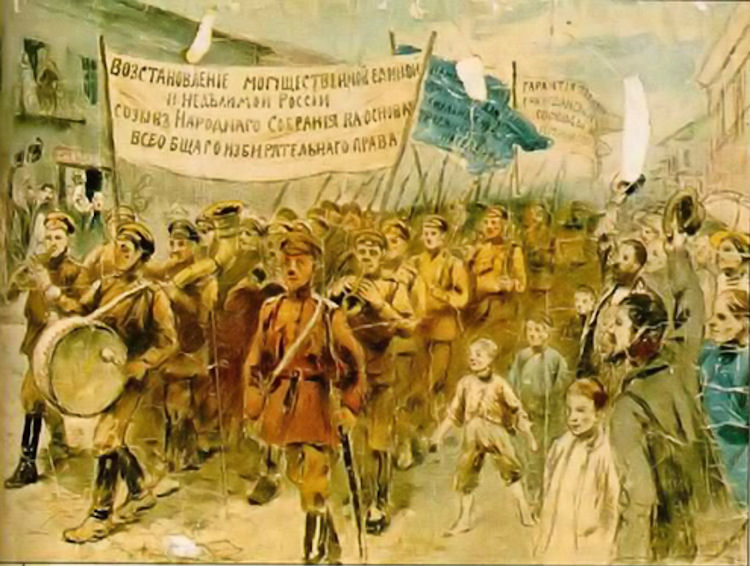
The Russian Civil War: A White Army Recruiting Poster
"Restoration of a Mighty, United, and Indivisible Russia. . ."

When Did World War One End?
With this issue of the Trip-Wire, I think I make the case that the Great War certainly wasn't over with the Armistice or the signings of the peace treaties. As you will see as you read on, many forces set loose in August 1914 carried over into 1919 and well beyond. Further, the disturbances and disruptions from the war ran into the 1930s and become part of the run-up to the Second World War. The same pattern recurs after 1945 as all the once vast colonial empires collapsed, and the Cold War and the Atomic, Space, and Information Ages ensued. For 30 years, I've held to a theory that a 75-Year Great War (1914–1989) had taken place. I was traveling in Europe when the Berlin Wall fell and I felt something had culminated for me and my side. I felt like I had been on the winning side of the Cold War and was optimistic about the future. Three decades later, however, I'm not sure anything important ended in 1989. The world of 2019 and America seems so different than 1989–with pessimism rather than optimism prevailing–I've no idea what's up ahead. I'm not sure if the lasting effects of the war are at the heart of our problems or there is something different and deeper, as yet undefined, operating. Possibly something spiritual or evolutionary. We'll see. MH

The Greek–Turkish War
(1919-1922)
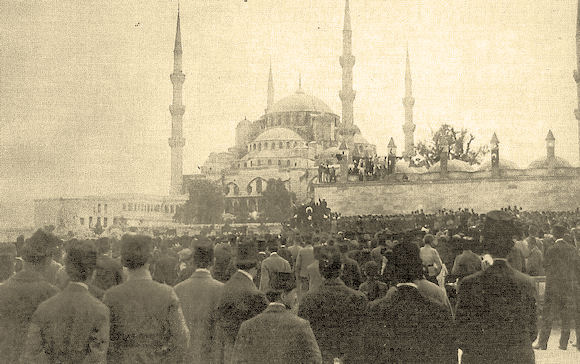
1919 Protest of the Allies' Occupation of Constantinople
By Christopher Kinley
One hundred years ago, the Greco-Turkish war erupted. The war resulted in the largest compulsory population exchange in history up to that time (two million people) and helped define the concept of ethnic conflict. The war also brought about the Turkish Republic and its severity indelibly shaped modern Greece and Turkey to this day.
The armistice of 11 November in 1918 is credited for ending the fighting of the First World War, but just 12 days prior, the Allied Powers and the Ottoman Empire signed the Armistice of Mudros. The Ottoman Empire was to be partitioned among the Allies, with all powers sending contingents to occupy Constantinople. As part of the deal, Greece received the city of Smyrna.
Smyrna was a wealthy city inhabited mostly by minorities in the Ottoman Empire: Greeks, Jews, and Armenians. For Greece, the city was more than just a prize for participation in World War I. It validated the Greek foreign policy goal of capturing Constantinople and reviving the Byzantine Empire, or “Greater Greece” as they called it."
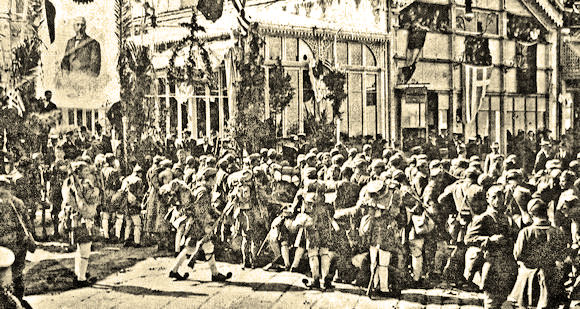
Greek Troops Landing in Smyrna, Turkey
Greek troops landed in Smyrna on 15 May 1919 and the war began. Local ethnic Greeks and Armenians joined forces with Greek troops. Reports soon circulated that these untrained volunteers committed acts of violence against their Muslim neighbors. Rumors of such brutality enraged an already growing revolutionary faction within the Ottoman Empire led by Mustafa Kemal.
Initially, the Greek Army’s intent was to secure the region surrounding the Smyrna occupation zone, but by the summer of 1920, Greek forces eyed Ankara and began to push deep into the heart of Anatolia. Britain backed this move into Turkish lands because it saw the Greek military as a conduit to crush Kemal’s revolutionary movement. By October of 1920, Greek troops had gained control of northwestern Anatolia. This advance, however, was met with staunch resistance.
Turkish revolutionary forces using guerilla warfare slowed the Greek Army’s progression, and Greek soldiers’ acts of violence against Muslim villagers created fear and panic and fueled ethnic conflict. In acts of reprisal, revolutionary forces brutally murdered Greek Orthodox villagers and forced many others to migrate east to the Greek occupation zone.
The violent acts against civilians committed by both sides did not go unnoticed by the international community and spawned numerous humanitarian relief campaigns.
As the fight dragged on, the Greek public grew weary of the war, and troop morale declined rapidly. Greek desertions soared.
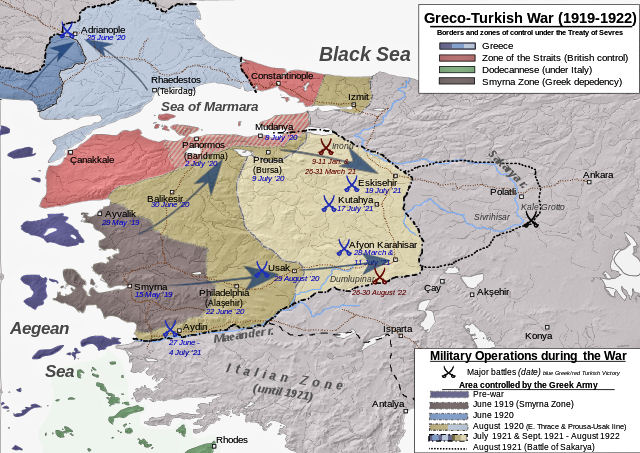
Britain, anxious about the perceived instability of the Greek government, withdrew its support. Into this vacuum, the Soviets began providing munitions to the revolutionary forces in an effort to check Western expansion and turn the tide of war in favor of Kemal’s movement.
By 1921, the Greek advance had stalled. The Battle of Sakarya in August saw heavy losses for the Greeks and was a strategic victory for the Turkish National Movement. For the Greek forces, this defeat completely halted any hope for advances and sent shockwaves through the government in Athens. After a heated parliamentary debate, the government decided it was far too invested to end the war. Plus, conceding defeat meant that Greece forfeited its territorial claims to Smyrna. This decision would prove disastrous.
Sakarya was the beginning of the end for the Greek campaign. The Greeks were forced to begin a slow retreat toward Smyrna. The final death knell came in August 1922 with the Turkish Great Offensive—over 100,000 Turks pitted against a disorganized Greek contingent of 200,000.
The military operation lasted 24 days and essentially crushed the Greek army, forcing a hasty retreat. The revolutionary forces captured 15,000 prisoners of war and encircled numerous divisions as they tailed the Greek troops to the coast. The Great Offensive concluded when the revolutionary forces entered Smyrna and the city erupted in flames.
Thousands of Greek and Armenian refugees, as well as Ottoman Turks, fled in horror, jumping into the sea to escape the fire. The scene was terrifying, as one British sailor described it watching from the deck of the HMS King George: “There were the most awful screams one could imagine… It was a horrible scene; mothers with their babies, the fire raging over their heads… and the people all screaming.”
It took nine days to extinguish the fire, and nearly 100,000 people perished in the flames. The great Ottoman city of Smyrna was reduced to ash. It was the end of the Greco-Turkish War and of a vision of a Greater Greece.
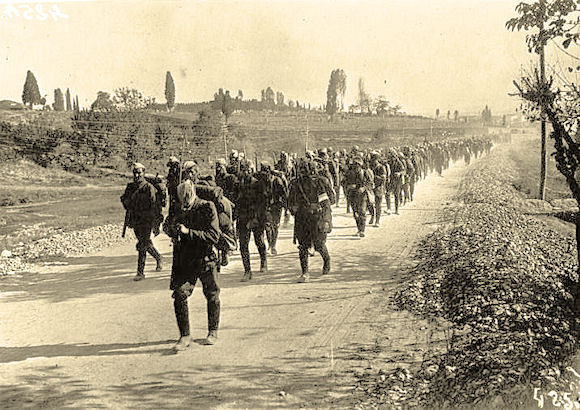
Defeated Greek Soldiers Retreating
For Kemal and his supporters, the victory was the birth of the Turkish Republic. Kemal abolished the sultanate to become the first leader of the new republic.
With the war over, the international community started peace negotiations. Britain, France, Italy, and others leading the peace talks decided that a compulsory population exchange was necessary to prevent the deaths of more innocent civilians.
With the Treaty of Lausanne in 1923, 1.5 million Orthodox Christians and 500,000 Muslims were forced to leave their homes. This population exchange put tremendous financial pressure on an already destabilized Greece, as the country had to care for 1.5 million new refugees. At the same time, it created financial issues for Turkey since many wealthy families were required to leave their homes and cross the Aegean.
The exchange solidified the idea of both Greece and Turkey as homegeneous nation-states. Although there were still minority communities left out of the exchange, Greece essentially became an Orthodox Christian nation, whereas Turkey became a Muslim republic. This war and the concept of religious homogeneity still causes tensions between the two countries today.
Source: Origins, the Ohio State/Miami University Historical Perspectives Blog
Visit Our Daily Blog

Click on Image to Visit
|
|
Merry Christmas 2019
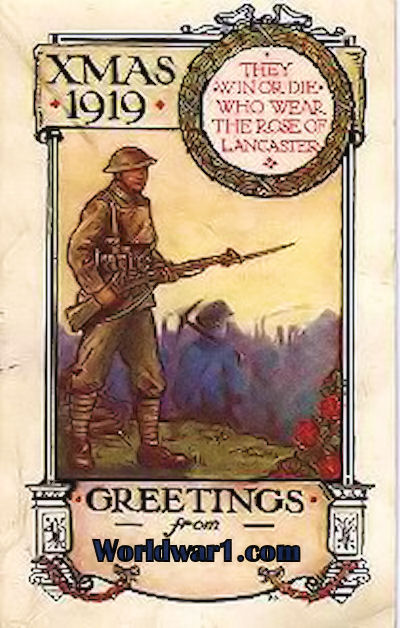

Related News from 1919
The Armistice of November 1918 did not end all the unfortunate upheavals that had been set off in August 1914. In 1919, multiple wars of independence, civil wars, and insurrections would break out. Turmoil would reign in the Middle East, and modernism–somewhat suppressed while the wholesale killing was going–on would break loose, as would a general reaction against change. Several articles about such matters are presented in this issue of Roads to the Great War. Here are some of the war-related stories of 1919.
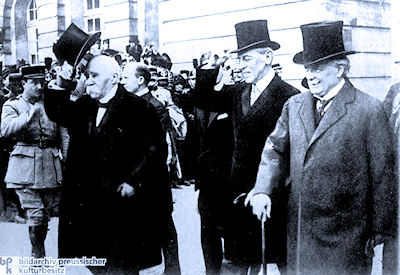
Versailles Treaty Signed:
28 June 1919
 The Short-Lived Faisal–Weizmann Agreement Is Signed, 3 January
The Short-Lived Faisal–Weizmann Agreement Is Signed, 3 January
 The Death of Theodore Roosevelt, 6 January
The Death of Theodore Roosevelt, 6 January
 The Bauhaus Founded, 12 April
The Bauhaus Founded, 12 April
 The Amritsar Massacre, 13 April
The Amritsar Massacre, 13 April
 First Transatlantic Flight of 1919, 16-31 May
First Transatlantic Flight of 1919, 16-31 May
 Scuttling of German Fleet at Scapa Flow, 21 June
Scuttling of German Fleet at Scapa Flow, 21 June
 D'Annunzio Marches into Fiume, 12 September
D'Annunzio Marches into Fiume, 12 September
 The Black Sox and the Great War, 1-9 October
The Black Sox and the Great War, 1-9 October
 The Volstead Act Bringing Prohibition to the United States Becomes Law, 28 October
The Volstead Act Bringing Prohibition to the United States Becomes Law, 28 October

The Spirit of 1919
In the fluid world of 1919, it was possible to dream of great change, or have nightmares about the collapse of order.
Margaret MacMillan, Paris 1919

The Polar Bears
They Were Late Coming Home
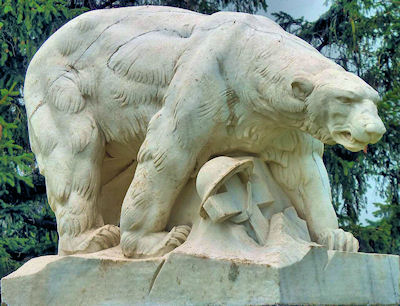
Polar Bear Memorial, Troy, MI
The American military intervention at Archangel, Russia, at the end of World War I, nicknamed the "Polar Bear Expedition," is a strange episode in American history. Ostensibly sent to Russia to prevent a German advance and to help reopen the Eastern Front, American soldiers found themselves fighting Bolshevik revolutionaries for months after the Armistice ended fighting in France. At some point, they named themselves the Polar Bears. (This mission should not be confused with the equally ill-conceived American military expeditions to Siberia. Those men found them themselves stuck among Cossacks, Reds, Czechs, and Japanese soldiers and irregulars until the spring of 1920. We have written about them at other places like HERE.
During the summer of 1918, the U. S. Army's 85th Division made up primarily of men from Michigan and Wisconsin, completed its training at Fort Custer, outside of Battle Creek, Michigan, and proceeded to England. While the rest of the division was preparing to enter the fighting in France, some 5,000 troops of the 339th Infantry and support units (one battalion of the 310th Engineers, the 337th Field Hospital, and the 337th Ambulance Company) were issued Russian weapons and equipment and sailed for Archangel, a Russian port on the White Sea, 600 miles north of Moscow within the Arctic Circle.
The strategy of the expedition's commanders was to advance south and east to join Russian and foreign anti-Bolshevik armies hundreds or even thousands of miles away. Fighting during the winter of 1918–1919 was concentrated in six areas scattered across Archangel Province in a semicircle south of the city. The Americans had a number of intense skirmishes, the most famous of which, the Battle of Toulgas, was fought 200 miles south of Archangel, ironically on 11 November 1918.
Morale declined over the grim winter with the troops—who were experiencing hit-and-run raids and growing dissatisfaction with the British command of the mission—increasingly feeling forgotten and confused about their mission. The boys came home in the summer of 1919 and the mission was officially disbanded 5 August.

The Returning Veterans
He had felt a certain satisfaction in the fact
that Christopher was going out, though he was confoundedly sorry too. He really
admired Christopher for doing it –and he imagined that it might clear some of the
smirchiness that must attach to Christopher’s reputation, in spite of what he now
knew to be his brother’s complete guiltlessness of the crimes that had been
attributed to him. He had, of course, been wrong—he had reckoned without the
determined discredit that, after the war was over, the civilian population would
contrive to attach to every man who had been to the front as a fighting soldier. After
all, that was natural enough. The majority of the male population was civilian, and,
once the war was over and there was no more risk, they would bitterly regret that
they had not gone. They would take it out of the ex-soldiers all right!
From: Last Post, Ford Madox Ford
Because we were duped I tell you, duped as even yet we hardly realize; because we were misused, hideously misused. They told us it was for the Fatherland, and meant the schemes of annexation of a greedy industry.--They told us it was for Honor, and meant the quarrels and the will to power of a handful of ambitious diplomats and princes.--They told us it was for the Nation, and meant the need for activity on the part of out-of-work generals!...Can't you see? They stuffed out the word Patriotism with all the twaddle of their fine phrases, with their desire for glory, their will to power, their false romanticism, their stupidity, their greed of business, and then paraded it before us as a shining ideal! And we thought they were sounding a bugle summoning us to a new, a more strenuous, a larger life. Can't you see, man? But we were making war against ourselves without even knowing it!. . .
From: The Road Back, Erich Marie Remarque
|

|
Western Front 1917 vs. Hollywood 2019:
The Matter of Looking Authentic
In my monthly film recommendations (the latest appears below) movies that don't look and feel authentic simply don't make the cut. This applies to documentaries as well as historical depictions and fictional treatments. Whenever I hear about Hollywood producing a major First World War film, I grimace. I'm never sure whether we will be getting something true to the historical record and passing the authentical-looking test like Tora, Tora, Tora or more like that ridiculous bomb, 1941. When I heard that a movie called 1917 was being produced by Hollywood, my initial response was to be very skeptical. However, as its December release has drawn near, bits of the movie and some still shots have been released, and I must say it seems to be beautifully filmed and I like the look. Here are two interesting scenes from 1917. I guess I'll have to go see it.
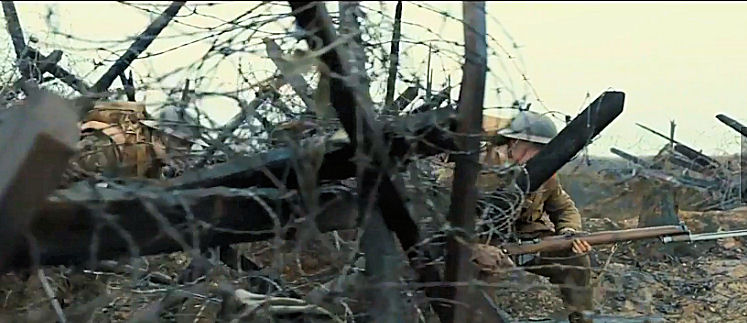
Moving Through Barbed Wire into No-Mans-Land
The two British Tommies shown here were given the mission of crossing no-mans-land to deliver a message to stop an imminent British attack that will lead 1600 soldiers into a trap. They apparently have lots of adventures on the way. After a 4 December Royal Premiere, Universal releases the DreamWorks/Amblin Partners film in a limited run on 25 December to qualify for the 2019 Academy Awards. It opens widely on 10 January 2019.
Sources: Deadline, IMDB
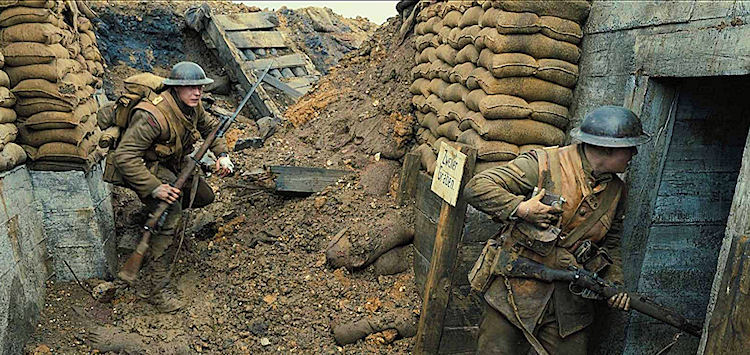
Scouting an Abandoned German Trench
The Emerging Totalitarians
1919 Was a Critical Year for Stalin and Hitler
In the aftermath of the war, the two great tyrants of the first half of the 20th century would sense their path to power and begin their movement to the top. By 1919, according to his biographer Robert Service, Josef Stalin was already recognized by Lenin and the inner party circle making up the Central Committee as an intelligent and decisive political operator, very willing to take on responsibility in difficult situations. In 1919 to achieve his expanded assignments, he would apply terror and violence on a greater scale than any of his colleagues, including Trotsky. This would both enhance his "can do" reputation and his already intimidating aura.
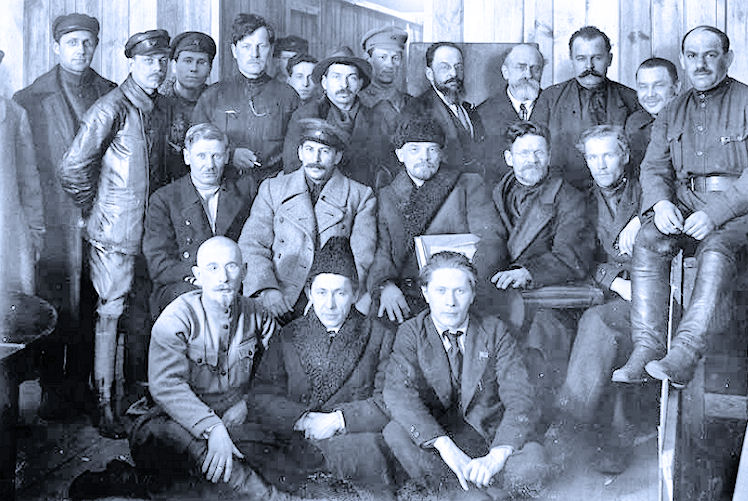
By May 1919 Stalin Had Made It to Lenin's Side
During the two years of Russia's Civil War, Stalin was active on or near the military fronts. In 1918 he led Red forces in strategically valuable—for the nation's food supply—Tsaritsyn on the Volga River. Challenging Trotsky, who was Chairman of the Revolutionary Military Council, he had out-maneuvered him to gain full control of the military units in the region. Once in control, he stabilized matters by applying a formula of executions of deserters and bandits along with the burning villages to ensure the cooperation of the peasants. His success at Tsaritsyn (which in 1925 would be renamed Stalingrad) marked him as a man who could restore a crumbling situation.
In May 1919, a larger crisis would provide Stalin with a greater opportunity to shine. A coalition of Russian and Finnish White forces supported by a British naval flotilla attempted to capture Petrograd. Further, there were concurrent mutinies among some Red units and fortress garrisons around the former capital. The Central Committee appointed Stalin to fix things, which he did in short order. Calling in Red Army reinforcements, he focused first on recapturing the forts and executing the traitors. The invading forces were then quickly routed and Stalin had another triumph. In November 1919, the government awarded him the Order of the Red Banner for his wartime service.
Come September he was returned to the Southern Front and began acting as if he were a law unto himself. In November Stalin threatened to resign over a minor matter, a technique he used repeatedly. Nevertheless, in the same month, the government awarded him the Order of the Red Banner for his wartime service. In 1920, with the Civil War effectively decided, Stalin would be drawn into the Soviet War with Poland, a struggle he had personally opposed. The defeat by the Poles would tarnish his reputation, but his behind-the-scenes role in the administration of party affairs would allow him to accrue more power in the meantime. "Koba" was on his way to the top.
Adolph Hitler, on the other hand, was nowhere as visible or influential in Germany, as was Stalin in Russia. His 1919 was spent observing the political scene in Bavaria, selectively demonstrating his oratorical skills, and what we today call networking with kindred souls. In October 1918, toward the end of World War I, Hitler had been partially blinded in a mustard gas attack near Ypres. He was sent to the military hospital in Pasewalk and was there at the time of the Armistice. Hitler returned to Munich on 21 November 1918, two days after his release from the hospital in Pasewalk, Pomerania.
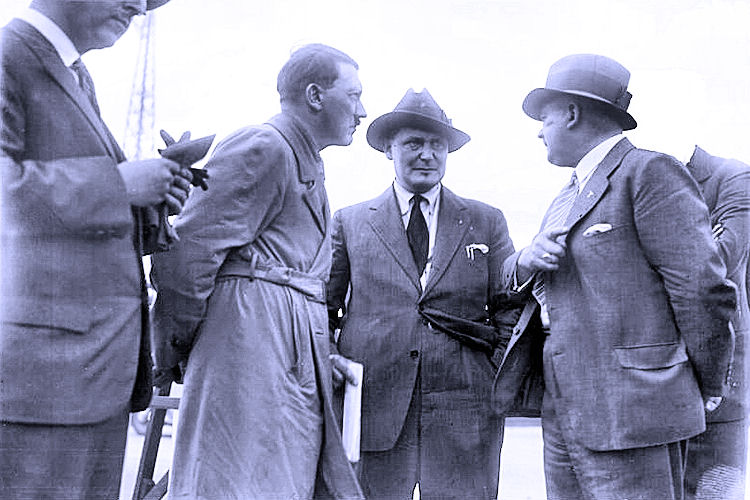
Hitler Connected with Herman Goering and Ernst Roehm (Right) Early in His Budding Career
During the next six months, Hitler had an opportunistic association as soldiers’ council representative to the civilian authorities in Bavaria with the Independent Socialist-led coalition Bavarian state government of Kurt Eisner, which assumed power in November 1918. After Eisner’s assassination by the fanatic Count Anton von Arco-Valley in February 1919, Hitler had a similarly opportunistic association with the Bavarian Soviet Councils Republic. He played no part in the overthrow of the Councils Republic on 2 May by Freikorps units, or in the establishment of the military administration that governed Bavaria until a civilian government could be formed.
At the end of May 1919, however, Hitler was recruited to work for the information office of the military administration commanded by Captain Karl Mayr. Among its tasks were gathering intelligence on political movements potentially hostile to the Bavarian authorities and tending to the “political education” of the troops to counter Bolshevik influences. Hitler excelled in a training course in early June, and in August 1919 became an instructor for a five-day course for Reichswehr (German Armed Forces) personnel at a base in Lechfeld near Augsburg. Hitler stood out as an effective communicator and made his first virulent anti-semitic speeches in Lechfeld.
Impressed with Hitler’s skills as a communicator, Mayr entrusted him with responding to a Reichswehr client request for elaboration on the so-called Jewish question. In a letter of 16 September 1919, Hitler first identified Jews as a so-called race that served as the “driving force” of Communist revolution in Bavaria.
In his intelligence--gathering function, Hitler and two colleagues attended a 12 September 1919, meeting of the German Workers Party (Deutsche Arbeiterpartei–DAP), a Völkisch-nationalist organization. During the meeting, Hitler denounced a speech favoring Bavarian separatism. Within a month, Hitler had joined the DAP with the number 555. Due to his speaking abilities, charisma, and tireless energy, Hitler quickly rose into the renamed National Socialist German Workers Party leadership ranks. He contributed significantly to the development and announcement of a new party program on 20 February 1920, at the Munich Hofbräuhaus. It called for German abandonment of the Treaty of Versailles, the expansion of German territory, and exclusion of Jews from citizenship. His discharge from the army came through on 31 March 1920.
Combining his considerable oratory capabilities with an unusual ability to read audience mood, both in individuals and large groups, Hitler established himself as absolute Führer (Leader) of the National Socialists by 1921. Under Hitler, the Nazi Party grew steadily in its home base of Bavaria. It organized strong-arm groups to protect its rallies and meetings. Within two years the party had grown to a membership of 55,000 and Hitler felt confident enough to launch his overly ambitious effort to overthrow the Weimar Republic, known as the Beer Hall Putsch. Imprisonment followed for him, but it provided an opportunity to become an author.
Sources: The Holocaust Museum, WW2Timelines, Wikipedia
Revolution in Germany
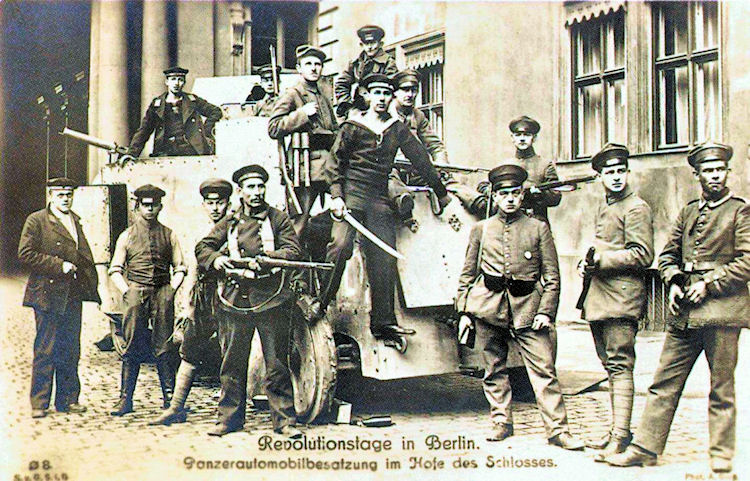
A German Veterans Friekorps Unit, Berlin
|
100 Years Ago:
The Voyage of the "Red Ark"
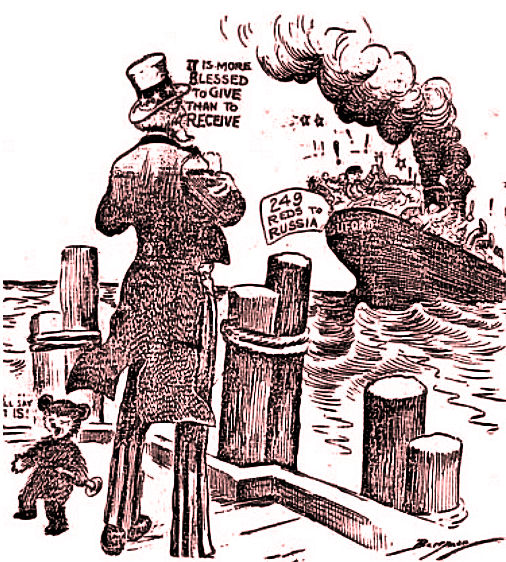
Contemporary Cartoon
In December 1919, nicknamed the "Red Ark" (or the "Soviet Ark") by the press of the day, the USAT Buford was used by the U.S. Department of Justice and Department of Labor to deport 249 aliens, including Emma Goldman, to Russia from the United States because of their left-wing, anarchist, or syndicalist political activities.
In 1919 Alexander M. Palmer, the attorney general and his special
assistant, John Edgar Hoover, organized a plan to deport a large
number of left-wing figures. On 7 November 1919, the second
anniversary of the Russian Revolution, over 10,000 suspected
communists and anarchists were arrested in 23 different
cities.
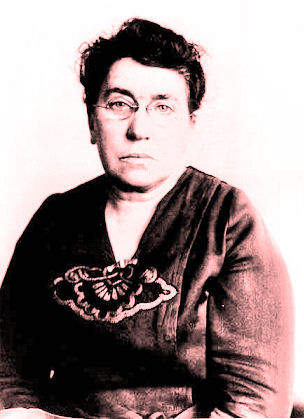
Emma Goldman
|
Hoover decided he needed a high-profile case to help his campaign
against subversives. He selected Goldman as he had been particularly
upset by her views on sexual matters (Emma's preferred mode of revolution) and religion. In court, however,
Hoover argued that Goldman's speeches had inspired anarchists to
commit acts of violence in the United States and won his case.
Goldman and her lover, Alexander Berkman, along with 247 other
radicals, were deported to Russia.
Emma eventually made it to Russia. Expecting Utopia, she was shocked about the lack of freedom there and personally informed Lenin of her disappointment. For the next two decades she journeyed the world as a vagabond preacher of progressivism, spreading joylessness and discontent wherever she stopped. Despite her exile, Emma managed to make it back to the U.S. twice, once for a speaking tour in the '30s and then for her burial in Chicago in 1940.
Sources: Ellis Island Website; Wikipedia
|

North Carolina's Breaking of the Hindenburg Line Commemorated
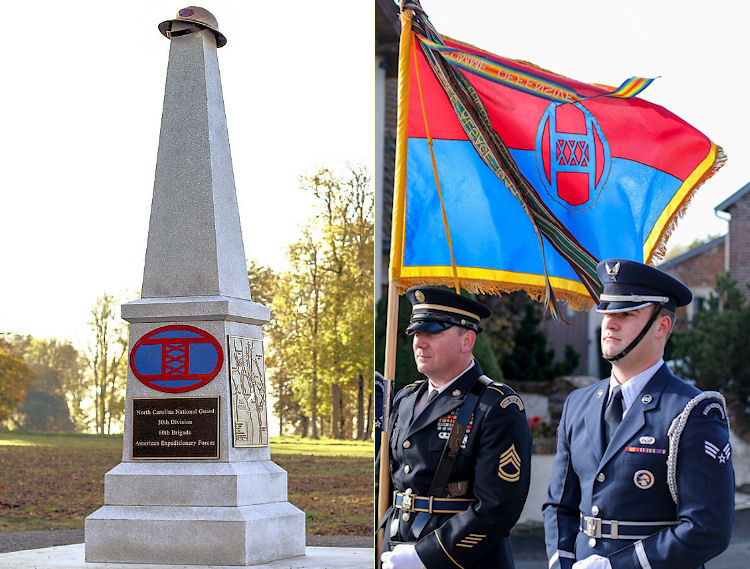
Nauroy, France
In late September 1918, the 60th Brigade (National Guardsmen from North Carolina) of the 30th AEF Division broke through the "impregnable" Hindenburg Line at the village of Nauroy, France. In a remarkably executed one-year effort–conceived of by proud North Carolinians John Merritt, David Sneeden, and Jerry Hester–the Tar Heel State has seen that the greatest achievement of its sons during the First World War will be remembered. On 10 November, 364 days after the project was conceived on Armistice/Veterans Day 2018, the monument shown above was dedicated on the site of the division's fighting at Nauroy.
Designed by Jeff Allen Associates of Winston-Salem, NC, the monument, features an obelisk on a large base with informational panels and was carved from North Carolina white granite. The sculpture is topped with a doughboy helmet mounted at a resting angle. The division patch is conspicuous on both the monument and the division flag carried by the color guard for the dedication. It superimposes "O" and "H" for "Old Hickory" (men from Tennessee filled out the rest of the division) on "XXX", signifying the 30th Division. Along the top of the flag in the photo can be seen the battle streamer for the 1918 victory.
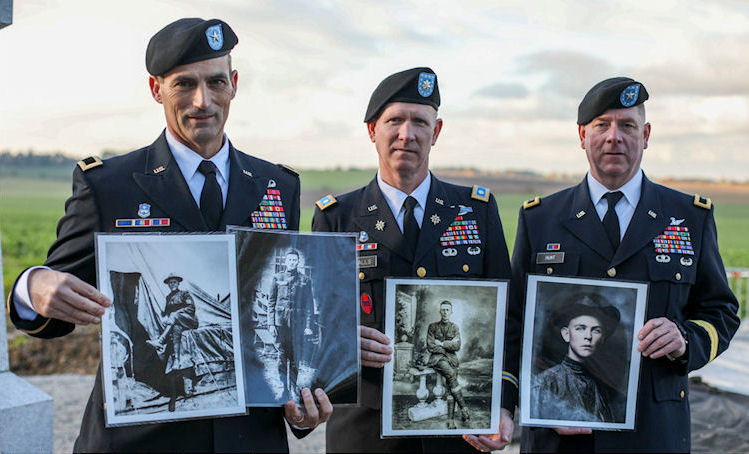
Three Officers of the North Carolina National Guard,
Who Had Grandfathers That Fought at Nauroy
Nauroy was on the front line for the last two years of the war and was fortified and incorporated into the German defensive network. The North Carolina memorial could not have been built without the wholehearted support of the village's citizens. The village lost many men in the war who are remembered at the community's nearby war memorial. Funding for the entire effort was made available through the generosity of the private citizens and counties of North Carolina, with the full support of the state's National Guard.
For more photos and details click HERE.
Sources: North Carolina National Guard
|
Support Worldwar1.com's Free Publications
|
Order Our
WWI Musical CD
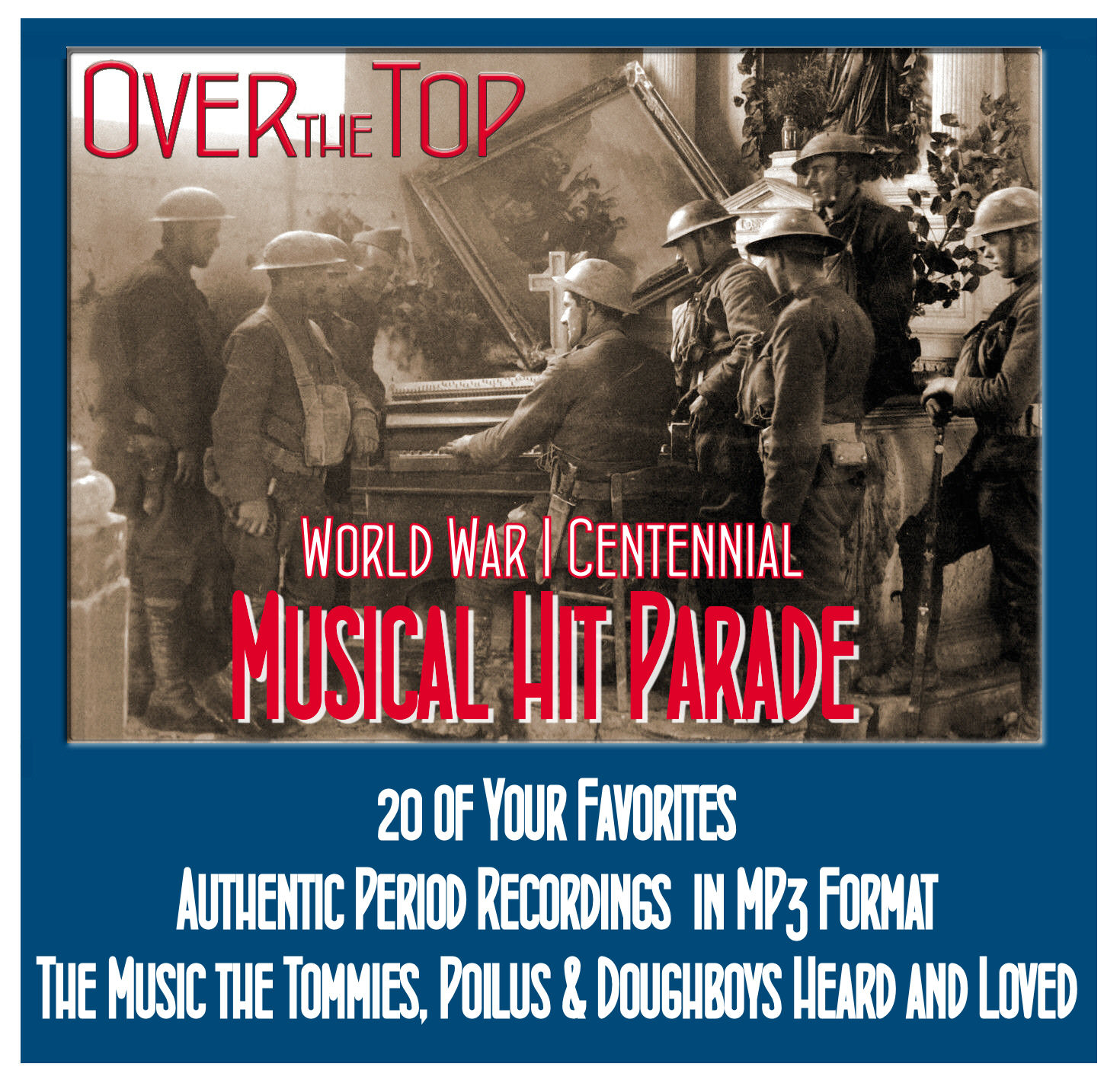
Click on Image for Information
|
Shop at
Amazon.com
|
Order the Complete Collection
Over the Top Magazine

Click on Image for Information
|
A World War One Film Classic
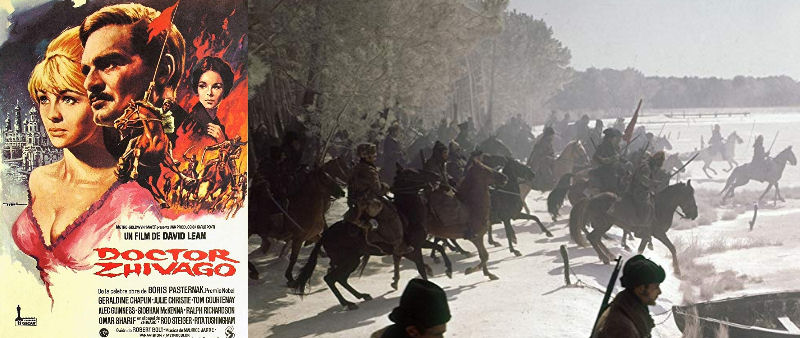
One of the greatest "epic" films ever produced, 1965's Doctor Zhivago covers the Russian experience from the run-up to the Great War, through the war itself, revolution, and civil war. Beautifully photographed with a moving soundtrack, the film informs by following the lives, loves, and tragedies of a core group of characters in a storyline that features subplots within plots, but director David Lean has arranged the scenes so, for the most part, viewers can follow the twists and turns. In the center of all is the poet/physician Yuri Zhivago. Played by Omar Sharif, his is an elusive and somewhat detached presence. The accompanying cast, however, delivers some indelible performances. Among my favorites were Alec Guinness as Yuri's Bolshevik half brother, Yevgraf, Tom Courtney as a brilliant, but mad, Trotsky-like character, and, of course, Julie Christie as Zhivago's deepest love, Lara. Ignore the 2002 on-the-cheap Masterpiece Theatre version of the story; see the movie. Available at both Amazon and Netflix.
|
|
Thanks to each and every one of you who has contributed material for this issue. Until our next issue, your editor, Mike Hanlon. |
|
 (Or send it to a friend)
(Or send it to a friend)
|
Design by Shannon Niel
Content © Michael E. Hanlon
|




























